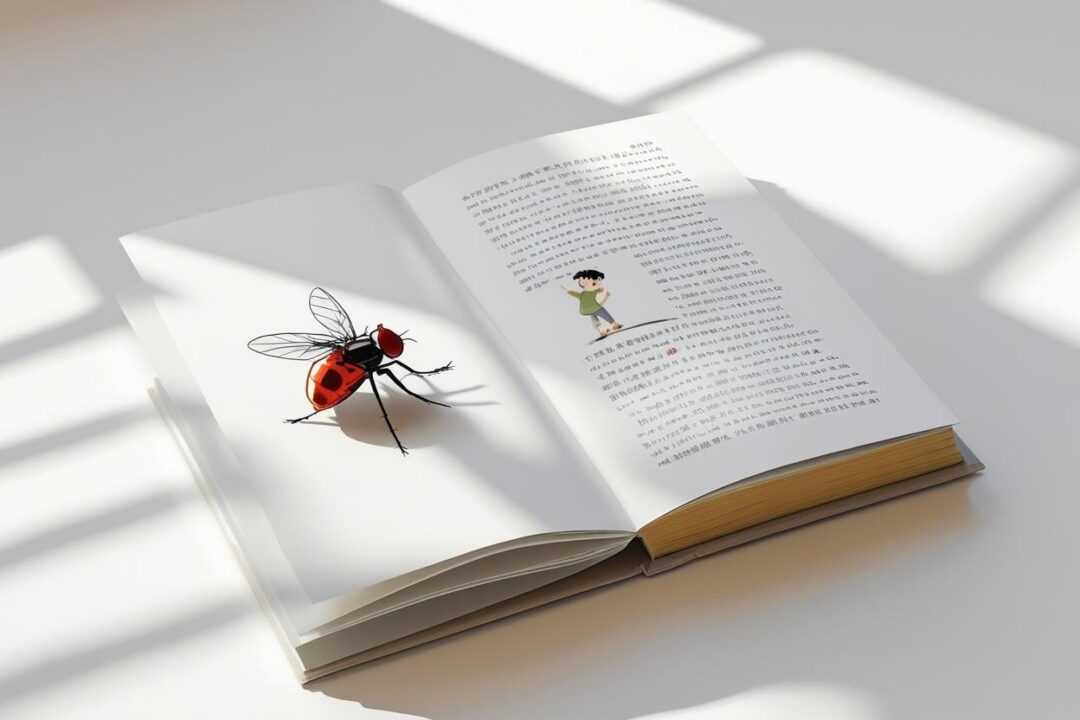William Golding’s Lord of the Flies is a literary classic that delves into the darkest aspects of human nature. Through the experiences of a group of boys stranded on an isolated island, the novel explores how societal structures collapse, revealing the savage instincts that lie within all humans. Among the characters, Simon stands out as a figure of purity, goodness, and spiritual insight. His role in the novel is profound, serving as a symbol of innocence and a voice of reason in the face of overwhelming chaos. But what does Simon truly represent in Lord of the Flies?
In this article, we will dissect Simon’s character, his acts of kindness, Christ-like symbolism, and unique perspective on the island’s events. We will explore how his actions and death are central to understanding Golding’s commentary on human nature and morality.
The Essence of Simon’s Character
Simon’s character is unique in Lord of the Flies. While Ralph and Jack represent the dichotomy of order versus chaos, Simon embodies a spiritual purity and moral clarity that sets him apart. Simon is consistently presented as a figure of goodness—his kindness, his empathy for others, and his connection to nature all contribute to his role as the moral center of the story.
From the beginning, Simon is depicted as a quiet, introspective boy, one who does not seek leadership but instead seeks peace in solitude. While the others are preoccupied with building shelters or hunting, Simon finds solace in the island’s natural beauty. This spiritual connection to nature plays a significant role in Simon’s character development and his eventual fate.
Unlike the other boys who are driven by the need for power, survival, or control, Simon’s journey on the island is one of reflection, understanding, and ultimately sacrifice. His ability to empathize with the animals and his profound spiritual awareness place him in sharp contrast to his peers.
Simon’s Background and Personal Traits in the Novel
Simon’s background is sparse in the novel. He does not have the strong leadership qualities of Ralph or the physical prowess of Jack. Instead, he is a quiet and humble boy with an innate sensitivity. His isolation is not due to any lack of desire for companionship but rather his natural inclination towards solitude and contemplation.
Simon’s solitude allows him to see things the other boys cannot. He is perceptive in a way that the others are not. While Ralph and Jack struggle to survive, Simon’s focus on the natural world and spiritual well-being gives him a unique insight into the deeper truths of the island. This quality allows him to understand the boys’ inner darkness—something the others fail to grasp.
Although Simon’s ability to see the truth isolates him, it also gives him a unique perspective on the unfolding events. He is the first character to realize that the “beast” the boys fear is not an external creature but the manifestation of their own darkness.
Acts of Kindness: Simon’s Compassionate Nature
Throughout the novel, Simon’s acts of kindness stand out in stark contrast to the violence and power struggles around him. While Jack thrives on hunting and domination, Simon is consistently selfless, helping others without seeking any recognition.
For example, Simon gives his food to the other boys without any expectation of reward. His act of kindness reflects his inner purity and sets him apart as a character who values the well-being of others above all. He also protects Piggy from the cruelty of the others, further emphasizing his moral compass. Simon’s selflessness represents the idea of goodness that exists even in the most brutal environments.
How Simon’s Good Deeds Reflect on his Character
Simon’s compassion is integral to his character. While the other boys grow increasingly savage, Simon remains a symbol of empathy and understanding. His good deeds are not driven by self-interest but by a moral sense of duty.
Simon’s character represents a moral ideal that is often rejected by the chaos surrounding him. His willingness to help others, his kindness toward animals, and his understanding of the deeper truths of the human experience reflect a purity that the island’s inhabitants have lost.
Simon’s Conversations with the “Lord of the Flies”
The most important symbolic moment in the novel comes when Simon encounters the “Lord of the Flies,” the severed pig’s head on a stick. In this chilling scene, Simon has a vision where the pig’s head speaks to him, revealing the true nature of the “beast” that the boys fear. Simon learns that the “beast” is not an external monster but an internal manifestation of the darkness within each of them.
This moment is pivotal because Simon becomes the first character to grasp the truth about the island’s true horrors. The “beast” is not a creature they can kill—it is their own fears and primal instincts. Simon’s tragic fate lies in his inability to communicate this truth to the others before he is killed. His encounter with the “Lord of the Flies” serves as the novel’s central moment of revelation and demonstrates Simon’s unique ability to perceive the underlying darkness of human nature.
Simon as a Symbolic Figure
Simon is not just a character; he is a powerful symbol in Lord of the Flies. He represents goodness, purity, truth, and spirituality in a world overtaken by violence and savagery. His role in the story is essential to Golding’s larger commentary on the human condition.
The Embodiment of Innocence and Goodness
Simon is often seen as the embodiment of innocence in Lord of the Flies. While the other boys descend into brutality and violence, Simon remains a figure of moral clarity. He is the one character who holds onto purity and innocence, but his eventual death symbolizes the loss of that innocence.
Simon’s connection to nature and his quiet, peaceful nature also contribute to his embodiment of goodness. Unlike Jack and Ralph, who view the island and the other boys through lenses of fear, power, and competition, Simon sees the island as a place of peace, harmony, and understanding.
Simon’s Christ-like Qualities and Sacrificial Role
Many literary critics have drawn parallels between Simon’s character and that of Christ. His selflessness, purity, and willingness to sacrifice himself for the greater good place him in direct alignment with Christ-like symbolism. In the novel, Simon is the only one who truly understands the nature of the “beast,” and his attempt to reveal the truth results in his tragic death.
Simon’s death mirrors Christ’s crucifixion in several ways. He dies for a truth that no one else understands or accepts, and his sacrifice is made in vain. His death is symbolic of the loss of innocence and the ultimate rejection of goodness in favor of savagery.
Instances of Simon’s Christ-like Symbolism in the Novel
Several key moments in Lord of the Flies reinforce Simon’s Christ-like symbolism. His solitary nature, his self-sacrifice, and his ultimate death all parallel aspects of Christ’s life and teachings. The most obvious instance of this symbolism is Simon’s death, which occurs during a chaotic and frenzied moment when the boys mistake him for the beast and kill him. This tragic act mirrors the crucifixion, as Simon’s message is misunderstood, and his sacrifice is rejected.
The Human Connection with Nature
One of the most distinctive features of Simon’s character is his deep connection with nature. Unlike the other boys, who are caught up in the material concerns of survival, Simon finds peace and solace in the natural world. His ability to appreciate the beauty and tranquility of the island sets him apart as a spiritual figure, deeply in tune with the rhythms of the earth.
How Simon’s Encounters with Nature Contribute to the Theme
Simon’s relationship with nature plays a crucial role in the development of the novel’s themes. His peaceful interactions with the island stand in stark contrast to the increasing violence and disorder surrounding him. While the boys grow increasingly savage, Simon remains connected to the world around him, offering a symbol of harmony and understanding.
Simon’s encounters with nature emphasize the novel’s central themes of civilization versus savagery. Simon is the only character who finds peace in the wilderness, while the others are consumed by their fears and primal urges. His ability to live in harmony with nature highlights the importance of balance and understanding in a world otherwise consumed by fear.
Simon’s Key Moments and Their Significance
Simon’s Encounter with the Beast: A Turning Point
Simon’s moment of revelation about the beast is one of the most important turning points in the novel. When Simon encounters the “Lord of the Flies,” he understands that the beast is not an external monster, but the evil that resides within each person. This realization changes the direction of the story, as Simon becomes the sole character who truly understands the nature of the terror the boys are experiencing.
This discovery of the beast’s true nature is a reflection of Simon’s moral clarity. However, it also marks the beginning of his tragic fate. His attempt to communicate the truth to the boys is met with violence, and his death signifies the ultimate rejection of goodness and truth.
The Tragic Climax: Simon’s Death and Its Impact
Simon’s death is the novel’s most tragic moment. After discovering the truth about the beast, Simon tries to return to the group to share his revelation. But in the frenzy of the boys’ fear, Simon is killed. This moment marks the end of innocence and the complete collapse of morality on the island. Simon’s death underscores the novel’s central theme of the fragility of civilization and the destructive nature of fear.
The Aftermath of Simon’s Death on the Other Characters
After Simon’s death, the boys descend even further into savagery. Ralph is horrified by what has happened, but his guilt and fear cloud his understanding. The group, now fully immersed in their primal instincts, continues down a path of violence and chaos. Simon’s death marks the complete loss of innocence, and from this moment forward, any possibility of returning to civility is gone.
Simon’s Prophetic Insights into Humanity’s Darkness
Simon’s ability to see the darkness within humanity is perhaps his most important characteristic. While the other boys are preoccupied with external threats, Simon understands that the true terror is internal. His insights into human nature make him a prophetic figure, capable of seeing the inherent evil within everyone on the island.
Key Quotes Illustrating Simon’s Insight and the Themes of the Novel
Simon’s conversations with the “Lord of the Flies” are critical moments in the novel, offering readers insight into the core of the boys’ fears. The quote, “I’m part of you,” spoken by the pig’s head, symbolizes the darkness within the boys and serves as a chilling revelation. Simon understands that the fear of the beast is not an external threat, but the darkness that lies within each of them.
Contrasting Simon with Other Characters
Simon and Ralph: Differing Perceptions of Leadership
Ralph and Simon represent different forms of leadership. Ralph’s approach is rooted in reason, order, and the practical aspects of survival. Simon, on the other hand, embodies a more spiritual and introspective leadership style, emphasizing understanding and compassion over structure and authority.
The Antithesis of Jack: Simon’s Peaceful Approach
While Jack thrives on power, violence, and hunting, Simon remains steadfast in his peaceful nature. His gentleness and selflessness serve as a stark contrast to Jack’s tyrannical leadership. Simon challenges Jack’s authority by refusing to give in to the primal instincts that drive the other boys, ultimately sacrificing himself for the truth.
Simon and Piggy: Intellectuals on Opposite Sides
Simon and Piggy are both intellectuals, but they approach knowledge and truth in different ways. Piggy relies on logic and reason, while Simon embraces spirituality and intuition. This contrast highlights the tension between intellect and intuition, reason and spirituality, that underpins the novel’s exploration of human nature.
Thematic Exploration Through Simon
Simon’s character is central to the novel’s exploration of morality, fear, and the loss of innocence. His actions and his ultimate sacrifice speak to the darker aspects of human nature and the challenges of maintaining goodness and truth in a world overwhelmed by savagery and fear.
The Loss of Innocence and the Concept of Evil
Simon’s character is central to the novel’s examination of innocence and evil. He is the last remaining symbol of purity on the island, and his death signifies the final loss of innocence. Simon understands the darkness within each individual, yet he is powerless to prevent its destructive force.
Morality and Ethics as Seen Through Simon’s Actions
Simon’s actions demonstrate his deep moral compass. His willingness to help others, his selflessness, and his understanding of the truth all reflect his strong ethical foundation. Simon is a character who embodies morality and goodness, yet his ultimate sacrifice suggests that in a world ruled by fear and violence, these values are often crushed.
What Simon’s Decisions Say About Human Morality
Simon’s decisions reveal a lot about human morality. His willingness to act in accordance with his understanding of the truth, even when it leads to his death, emphasizes the importance of standing by one’s convictions. Simon represents the idea that true morality is not just about surviving, but about holding onto one’s ethical beliefs, no matter the cost.
The Role of Fear and Superstition in Human Behavior
Simon’s tragic death underscores the powerful role fear and superstition play in human behavior. The boys’ collective fear of the “beast” leads them to commit the ultimate act of violence against Simon, who represents the truth. This event highlights the destructive power of fear and how it can cloud rational thinking and moral judgment.
Literary Analysis of Simon’s Character
Simon’s character is a rich tapestry woven with symbolism and depth, often serving as a moral compass within the chaos of the island. His presence in the narrative provides a contrast to the burgeoning savagery, offering a glimpse of hope and innate goodness that shines through the darkness enveloping the other boys.
Language and Imagery Associated with Simon
William Golding employs a unique set of language and imagery when describing Simon, often imbuing his scenes with a sense of mysticism and serenity. Words like ‘luminous’ and ‘peaceful’ accompany Simon, setting him apart from the stark, harsh imagery associated with the other boys. He is connected with nature in an almost supernatural way, reinforcing his role as an outlier and a beacon of light amidst the darkness.
Simon’s Role in Foreshadowing Events
Simon often appears as a harbinger of truth within the novel, his insights and encounters foreshadowing the dire outcomes faced by the boys. His interactions with the Lord of the Flies and his solitary wanderings hint at the deeper evil that lies within all humans, presaging the chaos that will eventually consume the island.
Analyzing the Symbolic Elements of Simon’s Encounters
Each encounter Simon has is rife with symbolic significance, from his communion with the natural world to his dialogue with the Lord of the Flies. These moments not only underscore his innate connection to a purer morality but also serve as a mirror, reflecting the internal struggles and corruption of the society the boys create. Simon’s experiences encapsulate the overarching themes of innocence, savagery, and the innate darkness within mankind.
Conclusion: The Lasting Symbolism of Simon
Simon’s character in Lord of the Flies stands as a lasting symbol of purity, morality, and spiritual insight. His tragic journey reflects the inherent struggle between goodness and savagery that exists within every human being. Simon’s selflessness and his unwavering connection to truth resonate across generations, offering readers a profound reflection on the fragility of innocence and the enduring power of empathy and self-sacrifice. His legacy in the novel serves as a timeless reminder that, even in the face of overwhelming darkness, the light of truth and goodness can offer hope, however fleeting. Simon’s representation transcends time, connecting with readers worldwide by illustrating the universal battle between our highest ideals and the destructive forces of fear and violence.



